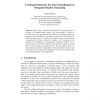Free Online Productivity Tools
i2Speak
i2Symbol
i2OCR
iTex2Img
iWeb2Print
iWeb2Shot
i2Type
iPdf2Split
iPdf2Merge
i2Bopomofo
i2Arabic
i2Style
i2Image
i2PDF
iLatex2Rtf
Sci2ools
ECSQARU
1997
Springer
1997
Springer
Creating Prototypes for Fast Classification in Dempster-Shafer Clustering
We develop a classification method for incoming pieces of evidence in Dempster-Shafer theory. This methodology is based on previous work with clustering and specification of originally nonspecific evidence. This methodology is here put in order for fast classification of future incoming pieces of evidence by comparing them with prototypes representing the clusters, instead of making a full clustering of all evidence. This method has a computational complexity of O(M . N) for each new piece of evidence, where M is the maximum number of subsets and N is the number of prototypes chosen for each subset. That is, a computational complexity independent of the total number of previously arrived pieces of evidence. The parameters M and N are typically fixed and domain dependent in any application.
Automated Reasoning | Computational Complexity | ECSQARU 1997 | Incoming Pieces | Nonspecific Evidence |
Related Content
| Added | 25 Aug 2010 |
| Updated | 25 Aug 2010 |
| Type | Conference |
| Year | 1997 |
| Where | ECSQARU |
| Authors | Johan Schubert |
Comments (0)

